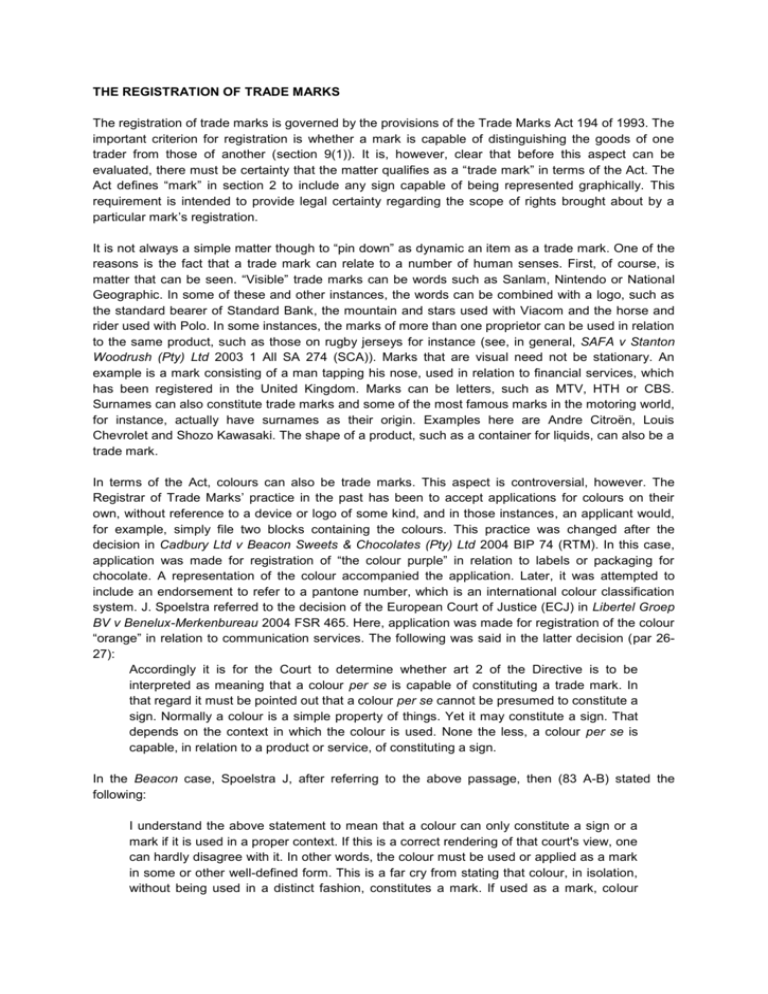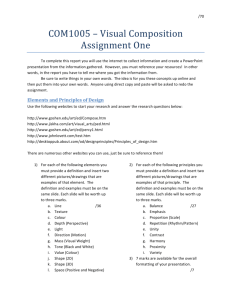tm reg
advertisement

THE REGISTRATION OF TRADE MARKS The registration of trade marks is governed by the provisions of the Trade Marks Act 194 of 1993. The important criterion for registration is whether a mark is capable of distinguishing the goods of one trader from those of another (section 9(1)). It is, however, clear that before this aspect can be evaluated, there must be certainty that the matter qualifies as a “trade mark” in terms of the Act. The Act defines “mark” in section 2 to include any sign capable of being represented graphically. This requirement is intended to provide legal certainty regarding the scope of rights brought about by a particular mark’s registration. It is not always a simple matter though to “pin down” as dynamic an item as a trade mark. One of the reasons is the fact that a trade mark can relate to a number of human senses. First, of course, is matter that can be seen. “Visible” trade marks can be words such as Sanlam, Nintendo or National Geographic. In some of these and other instances, the words can be combined with a logo, such as the standard bearer of Standard Bank, the mountain and stars used with Viacom and the horse and rider used with Polo. In some instances, the marks of more than one proprietor can be used in relation to the same product, such as those on rugby jerseys for instance (see, in general, SAFA v Stanton Woodrush (Pty) Ltd 2003 1 All SA 274 (SCA)). Marks that are visual need not be stationary. An example is a mark consisting of a man tapping his nose, used in relation to financial services, which has been registered in the United Kingdom. Marks can be letters, such as MTV, HTH or CBS. Surnames can also constitute trade marks and some of the most famous marks in the motoring world, for instance, actually have surnames as their origin. Examples here are Andre Citroën, Louis Chevrolet and Shozo Kawasaki. The shape of a product, such as a container for liquids, can also be a trade mark. In terms of the Act, colours can also be trade marks. This aspect is controversial, however. The Registrar of Trade Marks’ practice in the past has been to accept applications for colours on their own, without reference to a device or logo of some kind, and in those instances, an applicant would, for example, simply file two blocks containing the colours. This practice was changed after the decision in Cadbury Ltd v Beacon Sweets & Chocolates (Pty) Ltd 2004 BIP 74 (RTM). In this case, application was made for registration of “the colour purple” in relation to labels or packaging for chocolate. A representation of the colour accompanied the application. Later, it was attempted to include an endorsement to refer to a pantone number, which is an international colour classification system. J. Spoelstra referred to the decision of the European Court of Justice (ECJ) in Libertel Groep BV v Benelux-Merkenbureau 2004 FSR 465. Here, application was made for registration of the colour “orange” in relation to communication services. The following was said in the latter decision (par 2627): Accordingly it is for the Court to determine whether art 2 of the Directive is to be interpreted as meaning that a colour per se is capable of constituting a trade mark. In that regard it must be pointed out that a colour per se cannot be presumed to constitute a sign. Normally a colour is a simple property of things. Yet it may constitute a sign. That depends on the context in which the colour is used. None the less, a colour per se is capable, in relation to a product or service, of constituting a sign. In the Beacon case, Spoelstra J, after referring to the above passage, then (83 A-B) stated the following: I understand the above statement to mean that a colour can only constitute a sign or a mark if it is used in a proper context. If this is a correct rendering of that court's view, one can hardly disagree with it. In other words, the colour must be used or applied as a mark in some or other well-defined form. This is a far cry from stating that colour, in isolation, without being used in a distinct fashion, constitutes a mark. If used as a mark, colour must be ‘represented visually, particularly by means of images, lines or characters, so that it can be precisely identified’ (ibid [Libertel] at Para 28) and ‘the graphic representation must be clear, precise, self-contained, easily accessible, intelligible, durable and objective’ (ibid Para 29). The stated principles were then applied and it was held that the application was simply for the colour purple and that even if the endorsement was allowed, it would not have enabled the application to be registered. As the mark was too vague, without reference to the packaging of the products, it was concluded that it does not qualify as a “mark” as defined in the Act. Reference should also be made to the later decision of the ECJ in Heidelberger Bauchemie GmbH 2004 ECR I-6129. Here, the Court stated that the application for registration must include a systematic arrangement associating the colours concerned in a predetermined and uniform way (par 42). In summary, the position in South Africa appears to be that when a colour mark is applied for, an “extra” graphic representation is required. With regard to the merits of an application for a colour, the courts are cautious not to allow the depletion of the available colours of the spectrum and an exclusive right will not easily be granted. Insofar as a single colour, specifically, is concerned, prior use that would bring about distinctiveness would usually be required. In the Libertel case, the following was said in this regard (par 66): In the case of a colour per se, distinctiveness without any prior use is inconceivable save in exceptional circumstances, and particularly where the number of goods or services for which the mark is claimed is very restricted and the relevant market very specific. Use does, however, not equal distinctiveness. In Bergkelder Beperk v Vredendal Koop Wynmakery 2006 JOL 16901 (SCA), it was said, in paragraph 18, that: This court has rejected a similar argument because it is based on the unspoken and illogical assumption that “use equals distinctiveness” and loses sight of the fact that to be really distinctive of a person’s goods [a trade mark] must generally speaking be incapable of application to the goods of anyone else. Successful applications for colour marks include the colour turquoise for banking services – for Barclays Bank – in the United Kingdom and bananas with red tips (see the Australian decision in Fada Pty Ltd’s (t/a Pacific Coast Eco-Bananas) application WTLR, 19 May 2003). In other countries, in contrast with South Africa, the registration of unconventional trade marks, relating to other senses, has been attempted. Registration for tastes, such as strawberry, used in relation to pharmaceutical products, has been refused, among other reasons, as the mark was not distinctive. Registration for “smell” marks has been granted though. Examples include the smell of freshly cut grass in relation to tennis balls and the smell of roses registered in relation to tyres! Reference can be made here to the important decision of Sieckmann 2003 RPC 685. Here, application was made for a smell, including, among others, “a slight hint of cinnamon”, along with a chemical formula of the smell and a sample of the smell. The decision of the Court of Justice of the European Union, which actually formed the basis of the above cases dealing with colours, was to the effect that, inter alia, few people would recognise the formula (par 69). Although the word description of the smell was graphic, it was not sufficiently clear and objective (par 70). With regard to sound marks, an application for the yell of Tarzan has been refused, as it was not clear what the application related to. Incidentally, it is a common misconception that the distinctive sound of the Harley-Davidson motorcycles is registered. An application for the registration of the mark in the United States was, in fact, withdrawn, following opposition proceedings by a number of parties, including the major Japanese motorcycle manufacturers. If matter is a “mark”, the second question is whether it is “capable of distinguishing”. In this regard, a mark can be capable of so doing on two bases. On the one hand, a mark may be inherently distinctive (section 9(2)). Good examples are found in the music industry, with the names of groups such as Def Leppard, Bowling for Soup and Red Hot Chili Peppers. A mark can also become distinctive through use (Section 9(2)), subject, of course, to the above Bergkelder caveat. Examples here may be Good ’n Clean and Fresh, Shatterprufe and Pick ‘n Pay. With regard to the distinctiveness of a mark, the Registrar may require that a word that is of a descriptive or non-distinctive nature, particularly if it may be required for use by other traders, can only be registered subject to a disclaimer (section 15). An example may be an application for Zaza Juice, for fruit juice. The applicant will then have to disclaim exclusive rights to the word “juice”. The significance thereof is that the use of a (single) disclaimed feature cannot amount to infringement. Prof Wim Alberts (adapted version of an article first published in De Rebus) The refusal of an application on the basis that it is not distinctive is a so-called absolute ground of refusal. There are also relative grounds of refusal, which relate to the rights of third parties. A mark can, for instance, be opposed by the proprietor of a well-known mark, as envisaged in the Paris Convention (section 10(6)). Here, the mark does not have to be registered. Another instance, when a mark also does not have to be registered, is described in section 10(12). This would typically relate to marks that have a reputation through use. Sections 10(15) to (16) deal with the opposition of a later application or an earlier application when the opponent has existing rights (such as a restraint of trade). A mark can be opposed in terms of section 10(14), when it is to be used in relation to goods the same as or similar to an existing registered mark and when there is a likelihood of confusion. Last, section 10(17) provides for an opposition in the case of an application for the registration of a confusingly similar mark, the use of which would be likely to take unfair advantage of or be detrimental to the distinctive character or reputation of a well-known (or rather famous) registered trade mark, notwithstanding the absence of confusion. This would cover, for instance, an application for the mark Alfa Romeo for car polish, even if the proprietor of that mark does not have a registration for such products. After an application is accepted, it is advertised for opposition purposes. It can then be opposed within certain time periods. The grounds of opposition are the same as the grounds on which the application can be refused by the Registrar. The prescribed procedure corresponds to a large extent with that set out in rule 6 of the High Court rules. Prof Wim Alberts






